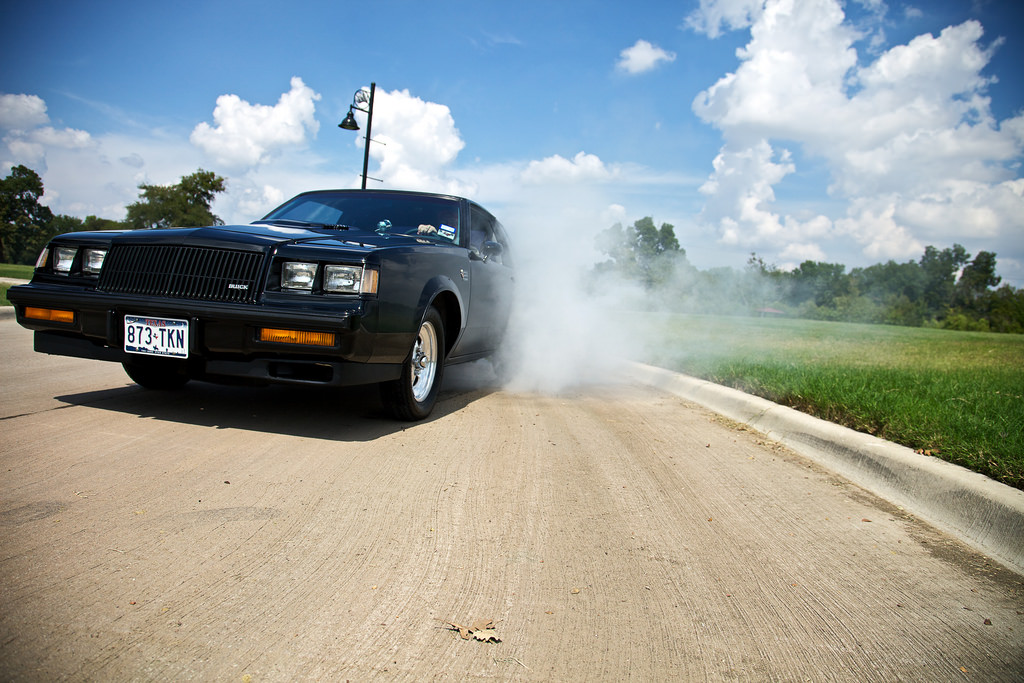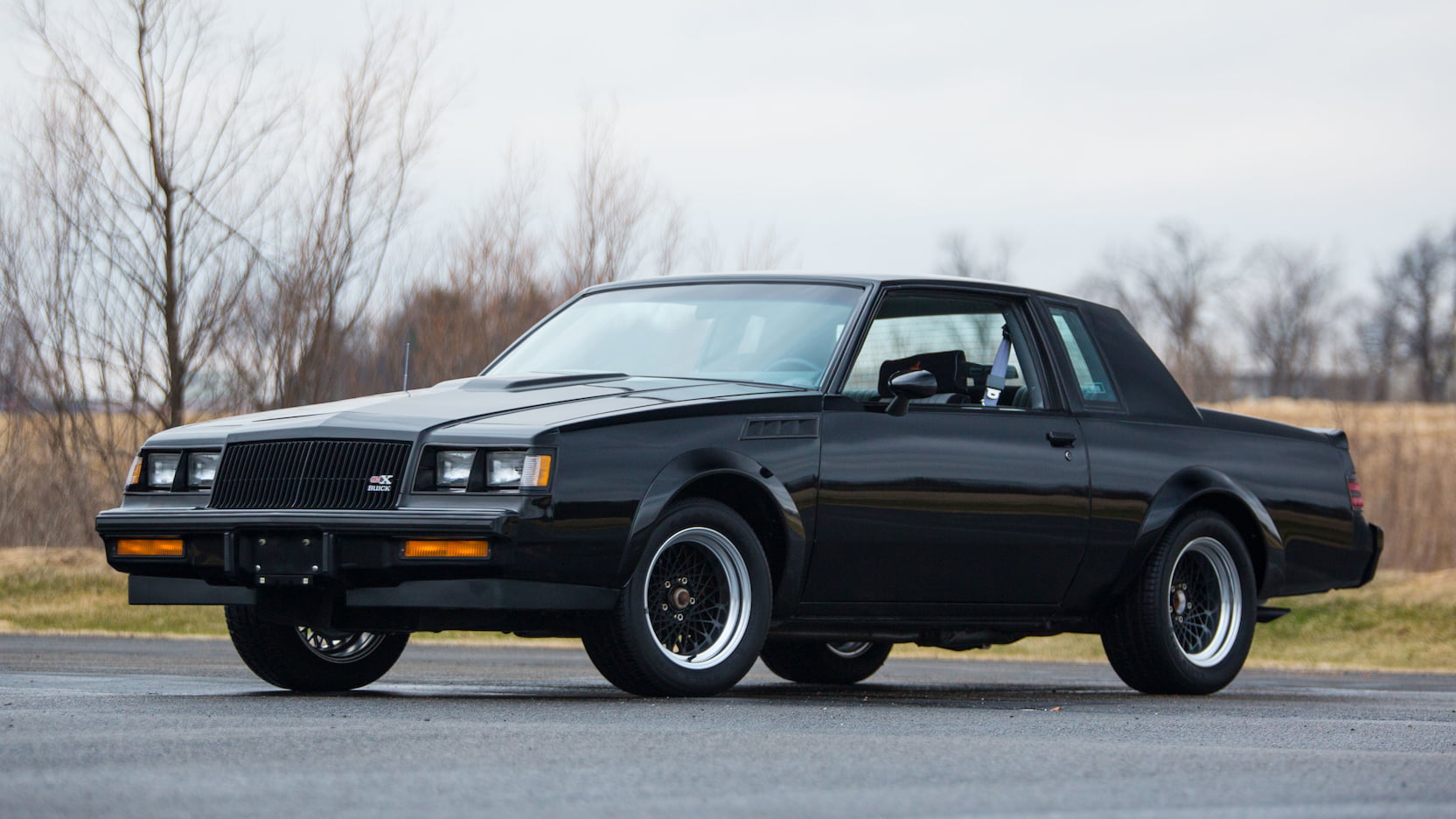Media | Articles
The day I smashed up a brand-new Buick GNX
When the Honda Accord smashed into the Buick GNX, I remember thinking only one thing, “My father is going to kill me.” It was June of 1987. The GNX was brand-new. It had maybe 1000 miles on its odometer. I was 17 years old.
My father was automotive journalist Joe Oldham. At the time he was editor-in-chief of Popular Mechanics magazine and the GNX, #002 of the 547 built, was part of Buick’s New York City press fleet. How did I end up behind the wheel of this muscle car icon? Simple, for a week I tirelessly begged my father to let me take it for a ride.
Buick GNX #003 recently sold at the Barrett-Jackson Scottsdale auction on live television for $126,500. When new, that car was in Buick’s Detroit press fleet, and was tested by Michigan-based publications and appeared in mags like Car and Driver and Autoweek. GNX #002 was sent to New York to be used by the northeast-based media like the New York Times and Popular Mechanics, which was the largest general interest men’s magazine in the world at the time.
Buick’s PR man in NYC and the staff member who held the keys to the press fleet was Martyn L. Schorr. Uncle Marty. He and my father were best friends. Still are. They worked at High-Performance Cars magazine together in the original muscle car era testing Hemi ‘Cudas and Baldwin-Motion Camaros. My father even wrote the forward to Schorr’s new book Day One: An Automotive Journalist’s Muscle Car Memoir, which was released this year.
Marketplace
Buy and sell classics with confidence
20180208165824)
So when the GNX arrived, my father got first dibs. After work on a Monday night, he walked from his office on 57th Street to the basement of the New York Coliseum where Schorr kept the cars. He walked right passed the LaSabre, the Electra Station Wagon, the Century and the Park Avenue, fired up the GNX and drove it home to suburbia.
Buick called the 1987 GNX the Grand National to end all Grand Nationals. It was the most powerful and quickest car GM built in the 1980s and it has become the premiere American collector car from the era. Its turbocharged 3.8-liter V-6 made 276 horsepower, which doesn’t sound like much now, but the GNX was the Dodge Challenger Demon of its day, running from 0-60 mph in 5.5 seconds and through the quarter mile in 13.43 seconds at 104 mph. That was quick enough to dominate the street, easily blowing off standard Grand Nationals, 5.0-liter Mustangs, IROC Camaros and even Corvettes. Chevy’s 195 hp Monte Carlo SS, also built on the G-body platform, wasn’t even in the same league.
On April 24, 1987, the first batch of 12 Grand Nationals left from GM’s Pontiac, Michigan, assembly plant to ASC’s Limited-Edition Vehicles Group in Livonia, Michigan, where they would receive modifications to their engines, suspensions, bodies, and interiors to become GNXs. According to Schorr’s book Buick GNX, which was published in in 1988, Buick took delivery of GNX #001, VIN 1G4GJ1174HP439259, on May 8th.
GNX #002, VIN 1G4GJ1179HP439256, arrived in Manhattan soon after. The car’s window sticker, which lists ASC McLaren as the manufacturer, appears in the book. The GNX option cost an additional $10,995 and it was the only GM product that year hit with the $650 gas guzzler tax. Add the $430 destination charge and the total price was $29,290. That was big bucks in 1987, but word was out and dealers marked them up to as much as twice the sticker price and they were getting it.
My father drove it to work in NYC the rest of the week up the New Jersey Turnpike and through the Lincoln Tunnel before dodging taxis and delivery trucks on the avenues of Manhattan Island. And if I know my father he was on it, building boost before drag racing everyone out of the Garden State’s many toll booths. He would leave early in the morning and return late after dinner, too tired to entertain my pleas for the keys. Every night my friends and I would sit in it in the driveway.

But that Sunday morning my father weakened. He said I could drive the car the 20 miles to my friend Chuck’s house to show him the car. Chuck was in his early 20s and his 1986 Grand National was hard to beat at the street races in Tom’s River, New Jersey, where we had met.
I remember driving to Chuck’s like an old lady knowing that if anything happened to the car I’d be sent off to military school or worse, orphaned. I arrived safely, parked the black Buick in the driveway next to Chuck’s and honked the horn. We spent a few minutes comparing the cars and then went for a ride.
With Chuck in the passenger seat I got on it once, brake-torqueing the engine up against its torque converter to make boost. I remember the suspension rising 4-5 inches as I held the car in place with the brakes and fed the throttle. This was unusual. Most cars would squat down on the rear suspensions, but to prevent rear axle windup ASC fitted the Buick GNX with a 30-inch long longitudinal torque arm which connected the rear axle to a steel crossmember that stiffened the chassis. The driveshaft passed through the crossmember so it also acted like a driveshaft shield in case a U-joint let go. When you would bring the car up on boost the torque arm would prevent axle wrap and ultimately wheel hop, but the pressure would push the rear of the car up.
At about 2500 rpm, just as the rear 16-inch Goodyear Gatorbacks started to spin, I let off the brake and launched the 3500 pounds of Detroit muscle down the road, keeping my foot down through the first three gears. The engine’s peak torque of 360 lb-ft hit at just 3000 rpm at 15 psi of max boost, and the GNX hazed the tires for the first 10 feet and then pinned us to its cloth-covered seats as the re-programmed 200-4R four-speed automatic clicked off two firm upshifts at 5000 rpm.
I remember Chuck saying something like, “Holy shit, this thing will smoke my GN.” I spoke to Chuck about four years ago. He still remembers the ride.
20180320135434)
20180320135450)
20180320135501)
About halfway home, still driving like the Golden Girls, a traffic light went from green to yellow as I approached. I stopped. It wasn’t a panic stop, but I remember getting on the brakes pretty good. And when I stopped I looked in the mirror and saw the Honda Accord coming. The only thing I could do was brace for the impact. It was a good one. I remember thinking the entire rear end of the car must be in the back seat. I gathered myself, opened the door and walked to the rear of the car.
The Honda looked like it had driven into a brick wall. Its fenders and hood were buckled, its grille was smashed and it was leaking coolant on the black asphalt. The young woman had a knot on her forehead where it had hit the steering wheel. She looked stunned. But when I turned to look at the Buick GNX I couldn’t believe my eyes. I was expecting to see carnage, but through some divine intervention, the car didn’t seem to be damaged at all. There was just a small dent and some scratching on the far left side of its black bumper under the rubber molding. That’s it. Thirty one years later I still can’t believe it.
After the police did their jobs, I drove the car home to face my father, who was about as mad as I had ever seen him. But after walking out to the car and surveying the damage he calmed down. After all, it wasn’t my fault. Just in the wrong place at the wrong time. My punishment was banishment from any press cars for six months. Hey, it beat military school.
The next morning the car was gone. Back in the garage at the Coliseum. Schorr sent it off to the dealer to get fixed and it was back in the hands of journalists a couple of weeks later. “Your father told me what happened. He said you were driving and got hit. I got it fixed up as quickly as possible. I don’t even remember looking at it,” says Schorr. “It was in high demand with the press. Everyone wanted that car.”
Apparently my father loved it so much he wanted to buy it asking Schorr to sell it to him after its time in the press fleet was finished. “I tried to get him the car,” says Schorr. “But GM said no. They told me they were keeping it for the company’s collection, along with GNX #001 and #500. Your father wasn’t the only one. I even got a call from Sylvester Stallone’s people.”
20170726013104)
A month or so after the crash, Schorr went to the press garage to check the mileage on the fleet cars, and something funny seemed to be going on. “The GNX had 60 miles on it that were unaccounted for,” said Schoor. “I later found out that one of the parking attendants had taken the car to Brooklyn and street raced it all night, bringing it back the next morning. The guy figured nobody would notice.”
Despite what Buick’s brass told my father and Sly, GM ended up selling GNX #002 to a dealer later that year who probably sold to someone with a suitcase full of cash. Buick GNX #001 and #500 are still owned by General Motors, but our research has failed to uncover the whereabouts of #002. It doesn’t appear in Hagerty’s database and it’s not listed in the GNX registry, which didn’t respond to our inquiries.
I’ve never seen the car since that Sunday in 1987. For the last 30 years, every time I see a GNX at a show or a cars and coffee I look inside and read the numbered dash plaque hoping it’s my old friend.
Does anyone out there know where it is? I wonder if that bumper is still tweaked.











That was good read!!
The relationship between a father and his son is more valuable than any car.
Carfax shows it was sold on 2/04/1989 with 9,000 miles to someone in Mooresville, IN. It’s still registered there to this day, last reported 5/08/2023.
The car you’re looking for is in a little town called salyersville ky. #002 in a garage and hasn’t been out in years
I hope you find it, and I hope you buy it.
I had a similar incident which shows how the GM cars of the 80s were tough. In 1994 I had a Mitsubishi Colt slam into the back of me. I was driving a 1981 Buick Skylark (my first car) and like you, I got out to see the Colt’s front end snakes beyond recognition. My Buick: the bumper was a little bent and the rear quarter panels had small outward dimples. Unless you were examining the car for any damage, you’d never notice anything. Now my Skylar wasn’t a #2 GNX, but it’s just kind of funny how those GM cars were built back then.